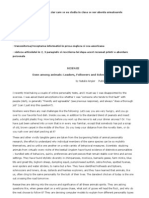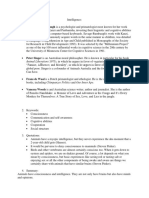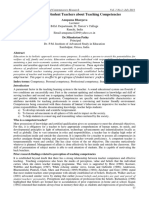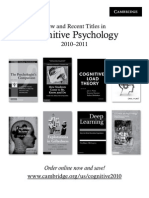Hcpdraft 1
Hcpdraft 1
Uploaded by
api-317164384Copyright:
Available Formats
Hcpdraft 1
Hcpdraft 1
Uploaded by
api-317164384Original Title
Copyright
Available Formats
Share this document
Did you find this document useful?
Is this content inappropriate?
Copyright:
Available Formats
Hcpdraft 1
Hcpdraft 1
Uploaded by
api-317164384Copyright:
Available Formats
Orozco 1
Andrea Orozco
Writing 39C
Dr. Lynda Haas
18 April 2016
A Historical Review on the Scientific Literature of Elephant Studies
Introduction
Ever since I was a little girl I have been amazed by these massive grey creatures with
enormous ears and long noses. I remember being around the age of seven I visited a
nearby zoo and actually had the privilege to ride an elephant. It was a privilege for me,
atleast. For the elephants not so much. According to the Economists Animal Minds,
most scientists can say with confidence that, some animals process information and
express emotions in ways that are accompanied by conscious mental experience. With
that being said, I will be doing a literature review on elephant studies through mourning
and intelligence of elephants to prove that they have full consciousness and they should
not be used as entertainment in any way, shape, or form.
The Beginning of the Study of Animals
The study of animals all began with Charles Darwin. As Darwin argues, there is no
doubt that there is a great gap between the lowest man and the highest animal.
Nevertheless the difference in mind between man and the higher animals, great as it is,
certainly is one of degree and not of kind (Darwin 128). He adds to say that our senses
and emotions, such as love, memory, attention, curiosity, imitation, and reason, may be
found in even the lowest animals. Since the start he had faith in the highly-advanced
intellectual faculties of animals in general.
Orozco 2
Mourning
It is easy to say that animals have emotions, a common one being fear, but elephants,
for example, are one of the many animals that go through the process of mourning
when they face traumatic events. When it comes to animals, one usually thinks of fear
being one of the few emotions they possess. Elephants, surprisingly, demonstrate the
broad emotions they hold, mourning, being one of the more studied emotions. In her
2004 article, Not by Bread Alone: Symbolic Loss, Trauma, and Recovery in Elephant
Communities Isabel Bradshaw, an American psychologist and ecologist, elaborates on
how, just like humans, elephants have encountered a great amount of stress and
trauma and have found ways to respond to this through processes, rituals, and social
structures. Trauma theory has broughten great attention to psychological damage that
victims of violence experience and here we are able to see how elephants are affected
by systematic violence.
According to Do Elephants Show Empathy? by Richard Byrne, psychologist from the
University of St Andrews, et al, this source is a research article that compiles over thirtyfive years of reports describing the behavior of elephants with potential to revealing
signs of empathetic understanding. Some of these traits being babysitting calves,
protecting and comforting others, and removing foreign objects from one another. In
general the records demonstrate how elephants are capable to empathetic
understanding of others through these abilities and also discuss why elephants show
more empathy compared to other non-primates. Byrnes presents observational reports
of elephants that respond to the emotional states of others. Focusing in the Amboseli
Orozco 3
ecosystem in southern Kenya, the elephant population has been studied over the past
thirty-five years by members of the Amboseli Trust for ELephants (ATE). Some things
they found is the characteristic of protection, for example, when a young or injured
individual is in a potentially dangerous situation, but is unable to defend itself sufficiently,
it may receive protection from another elephant (Byrnes 209). The list of observations
goes on including similar concepts like comfort, babysitting, and removing foreign
objects from another individual.
Some zoos have become more sensitized to animal emotions. For example, several
years ago, a zoo got in contact with an animal communicator to consult with their
elephants because of strange behavior they had been having. The consultant learned
that one of their elephant companion had recently died and he believed that the body
had been removed too soon and therefore didnt give the elephants a chance to mourn
and say their goodbyes. The elephants skull was then brought back to the elephants
and they immediately gathered around it and began their ritual involving touching and
caressing (Bradshaw 149).
Not only do elephants mourn when it comes to responding to trauma, they also show
intrusive behavior. In some cases explained by Bradshaw, reintroduction of elephants
into social groups disrupts their social bonds and they are usually denied participation in
rituals which leads to a culture of extremely violent males. Translocated juvenile
elephants have been found in many occasions to release their their stress by rampaging
through reserve and killing rhinos, attacking tourist vehicles, and even going as far as
threatening older female elephants.
Orozco 4
Intelligence
Elephants are one of the most studied animals when it comes to learning about animal
intelligence. Evolutionary biologist, Bernhard Rensch, explores elephant intelligence
through various experiments conducted at a German zoo and compiles his findings in
his article, The Intelligence of Elephants. He starts off his article by stating the general
rule of the animal kingdom the bigger the brain, the greater the brain power. Elephants
are not only the largest land mammals, but they also have the largest brains weighing in
at almost 13 pounds. Through his experiments on intelligence trials, Rensch
hypothesized that brain size actually does contribute to intelligence as larger animals
develop the complicated parts of the cerebral cortex to a greater degree and also had a
greater learning ability (44).
Rensch had the privilege to travel to India and study the taming and training of working
elephants. Here the process is as soon as a new elephant is caught, he is assignment
to a mahout meaning elephant boy. Of course after being in this new environment the
elephant can at any moment freak out and is soothed by grass or the signing of
soothing melodies. To Renschs surprise, after two to three weeks of daily training, the
elephants quickly learned commands such as Go!, Stop!, Kneel down! and so forth.
Rensh then sought out to find out how large a vocabulary a trained elephant could
understand. His observations of the Indian working elephants ability to learn
vocabulary prompted him to make a laboratory examination of elephants acoustic
discrimination.
Orozco 5
In an experiment for discrimination
between sounds, Elephants were put
into cells and given positive and
negative sounds. As shown in figure 1,
when an elephant heard a positive toe,
she knocked on a box with her trunk
(top). What this did was it closed an
electrical circuit which then moved
another box containing bread towards
the elephant (middle). When given a
negative tone the elephant knew to
wrap her trunk around the horizontal
bar of her cell (bottom).
Works Cited
"Animal Minds." The Economist. The
Economist Newspaper, 26 Oct. 2015. Web. 24
Apr. 2016.
Bekoff, Marc. "Animal Emotions: Exploring Passionate Natures." BioScience. 2000.
Web. 18 Apr. 2016.
Bradshaw, Isabel Gay. "Not by Bread Alone: Symbolic Loss, Trauma, and Recovery in
Orozco 6
Elephant Communities." Society & Animals 12.2 (2004): 143-58. Web. 20 Apr.
2016.
Darwin, Charles. The Descent of Man. Amherst, NY: Prometheus, 1998. Print.
Irie, Naoko, and Toshikazu Hasegawa. "Elephant Psychology: What We Know and
What We Would like to Know." Japanese Psychological Research 51.3 (2009):
177-81. Web. 19 Apr. 2016.
Rensch, B. "The Intelligence of Elephants." Sci Am Scientific American 196.2 (1957):
44-49. Web. 23 Apr. 2016.
You might also like
- The Dog's Mind: Understanding Your Dog's BehaviorFrom EverandThe Dog's Mind: Understanding Your Dog's BehaviorRating: 4 out of 5 stars4/5 (9)
- Chapter 7 - Fostering Language AwarenessDocument23 pagesChapter 7 - Fostering Language Awarenessfitri100% (1)
- If You Tame Me: Understanding Our Connection With AnimalsFrom EverandIf You Tame Me: Understanding Our Connection With AnimalsRating: 5 out of 5 stars5/5 (1)
- TKT Unit 16 PracticeDocument8 pagesTKT Unit 16 PracticePorntip Bodeepongse รักในหลวง100% (4)
- Hcpdraft1 3 3Document7 pagesHcpdraft1 3 3api-317164384No ratings yet
- Apfinalfinal 4Document12 pagesApfinalfinal 4api-317164384No ratings yet
- HCP Rough DraftDocument9 pagesHCP Rough Draftapi-321001417No ratings yet
- A Historical Review On Elephant IntelligenceDocument7 pagesA Historical Review On Elephant Intelligenceapi-291120668No ratings yet
- HCP Final DraftDocument9 pagesHCP Final Draftapi-321001417No ratings yet
- HCP TriciaDocument9 pagesHCP Triciaapi-291120668No ratings yet
- Module 1 Introduction To Pet PsychologyDocument7 pagesModule 1 Introduction To Pet Psychologyk.magdziarczykNo ratings yet
- Surprise - Elephants Comfort Upset FriendsDocument5 pagesSurprise - Elephants Comfort Upset FriendsdillipinactionNo ratings yet
- Animal Consciousness: Evolution and Our EnvironmentDocument11 pagesAnimal Consciousness: Evolution and Our EnvironmentmelitalazNo ratings yet
- Can Animals Think LindenDocument4 pagesCan Animals Think LindenRogerio PrestesNo ratings yet
- Annotated Bibliography BaileyDocument6 pagesAnnotated Bibliography Baileyapi-405492729No ratings yet
- Human Perceptual and Phobic Biases For Snakes A Review of The Experimental EvidenceDocument15 pagesHuman Perceptual and Phobic Biases For Snakes A Review of The Experimental EvidenceJillianne FrancoNo ratings yet
- What We Owe Our Fellow Animals - Martha C. Nussbaum - The New York Review of BooksDocument12 pagesWhat We Owe Our Fellow Animals - Martha C. Nussbaum - The New York Review of BooksandreamartinezoyeclaNo ratings yet
- Pride Paper Final 3Document15 pagesPride Paper Final 3api-477139378No ratings yet
- PET Psychology Module 1Document9 pagesPET Psychology Module 1Oana DumbravaNo ratings yet
- Elephants Call Each Other by NameDocument3 pagesElephants Call Each Other by NameSindhujaNo ratings yet
- A Change of Heart About AnimalsDocument2 pagesA Change of Heart About AnimalsRohith GopalNo ratings yet
- Home Biology Basics: o o o o o o o o o o oDocument23 pagesHome Biology Basics: o o o o o o o o o o oyulianaNo ratings yet
- 6_Emotional AgencyDocument30 pages6_Emotional Agencyflodoll1999No ratings yet
- Report Text - 1Document10 pagesReport Text - 1lautynadi18No ratings yet
- Can Animals ThinkDocument18 pagesCan Animals ThinkABNo ratings yet
- Do Animals Have Emotions?: PUREC DAVID, VM, GR.2.5.09Document13 pagesDo Animals Have Emotions?: PUREC DAVID, VM, GR.2.5.09Viv LorteNo ratings yet
- THE SECRET LANGUAGE OF ANIMALS: A Guide To Remarkable Behavior by Janine Benyus, Illustrated by Juan Carlos BarberisDocument32 pagesTHE SECRET LANGUAGE OF ANIMALS: A Guide To Remarkable Behavior by Janine Benyus, Illustrated by Juan Carlos BarberisBlack Dog & Leventhal67% (3)
- HCP - First DraftDocument9 pagesHCP - First Draftapi-279026766No ratings yet
- Auby Annotatedbibliography 10-17-2014Document1 pageAuby Annotatedbibliography 10-17-2014api-263942603No ratings yet
- The Odd Body I: Mysteries of Our Weird and Wonderful Bodies ExplainedFrom EverandThe Odd Body I: Mysteries of Our Weird and Wonderful Bodies ExplainedNo ratings yet
- STSDocument2 pagesSTSMaxine TaeyeonNo ratings yet
- BQ Fundamental NegDocument8 pagesBQ Fundamental NegJohn PetersonNo ratings yet
- Kingdom of Play: What Ball-bouncing Octopuses, Belly-flopping Monkeys, and Mud-sliding Elephants Reveal about Life ItselfFrom EverandKingdom of Play: What Ball-bouncing Octopuses, Belly-flopping Monkeys, and Mud-sliding Elephants Reveal about Life ItselfRating: 4 out of 5 stars4/5 (2)
- Bio 422 Animal Behaviour Lecture Notes Second SemesterDocument20 pagesBio 422 Animal Behaviour Lecture Notes Second Semesterpatmarys2470% (1)
- 1 3套综合写作文本及范文Document5 pages1 3套综合写作文本及范文David ZhaoNo ratings yet
- Race, Sexual Orientation, Age, Religion, Creed, Disability and Gender, Do Not ExistDocument3 pagesRace, Sexual Orientation, Age, Religion, Creed, Disability and Gender, Do Not ExistМаша МатвійчукNo ratings yet
- Shark PersonalitiesDocument2 pagesShark PersonalitiespvarillasNo ratings yet
- Animal Behaviour & Ethology Avneesh BishnoiDocument20 pagesAnimal Behaviour & Ethology Avneesh BishnoiAishwary SinghNo ratings yet
- Through Animal Eyes: What Behaviour Tells Us: Marian Stamp DawkinsDocument7 pagesThrough Animal Eyes: What Behaviour Tells Us: Marian Stamp Dawkinsapi-3806979No ratings yet
- Article About Horse CommunicationDocument87 pagesArticle About Horse CommunicationMuhammad HaritsNo ratings yet
- TeksDocument2 pagesTeksSfi adiaptri18No ratings yet
- Animal Emotions: Exploring Passionate Natures: ArticlesDocument18 pagesAnimal Emotions: Exploring Passionate Natures: ArticlesViv LorteNo ratings yet
- Reading 3 - AdditionalDocument4 pagesReading 3 - AdditionalDai NgoNo ratings yet
- What A Dog Can Do Children With Autism and Therapy Dogs in Social Interaction PDFDocument24 pagesWhat A Dog Can Do Children With Autism and Therapy Dogs in Social Interaction PDFPaulinaNo ratings yet
- Animal Happiness: Moving Exploration of Animals and Their Emotions - From Cats and Dogs to Orangutans and TortoisesFrom EverandAnimal Happiness: Moving Exploration of Animals and Their Emotions - From Cats and Dogs to Orangutans and TortoisesRating: 4 out of 5 stars4/5 (15)
- Animal BehaviorDocument36 pagesAnimal BehaviorDobiam NarbaNo ratings yet
- Chemical Communication: Sources of OdoursDocument3 pagesChemical Communication: Sources of OdoursTawanda ChibweNo ratings yet
- Listening Exercise Elehants TRS4Document2 pagesListening Exercise Elehants TRS4Nguyen Dang Cuong (K18 Hl)No ratings yet
- Elephant CognitionDocument15 pagesElephant CognitionPedro ButtelliNo ratings yet
- Science Even Among Animals: Leaders, Followers and SchmoozersDocument8 pagesScience Even Among Animals: Leaders, Followers and SchmoozersIfrim AdrianaNo ratings yet
- Did You Know That: Angelyne PotencianoDocument10 pagesDid You Know That: Angelyne PotencianoAngelyne PotencianoNo ratings yet
- Animal Liberation (1975), in Which He Argues in Favor of Vegetarianism, and His EssayDocument3 pagesAnimal Liberation (1975), in Which He Argues in Favor of Vegetarianism, and His Essayapi-399653876No ratings yet
- 1 IntroduzioneDocument59 pages1 IntroduzionemuramadNo ratings yet
- Beastly Brains: Exploring How Animals Think, Talk, and FeelFrom EverandBeastly Brains: Exploring How Animals Think, Talk, and FeelRating: 4 out of 5 stars4/5 (4)
- Final Draft ApDocument15 pagesFinal Draft Apapi-318309571No ratings yet
- Why Don't Animals Talk - Davidson Institute of Science EducationDocument8 pagesWhy Don't Animals Talk - Davidson Institute of Science Educationתומר אדריNo ratings yet
- Animals Think and FeelDocument5 pagesAnimals Think and FeelAndhita Satya Pratama GiovanniNo ratings yet
- Developed by W. Huitt & J. Hummel (1999)Document26 pagesDeveloped by W. Huitt & J. Hummel (1999)kimigasukiNo ratings yet
- Perception of Student Teachers About Teaching Competencies: Anupama BhargavaDocument5 pagesPerception of Student Teachers About Teaching Competencies: Anupama BhargavaLulu FauziyahNo ratings yet
- Approach Motivation and Positive AffectDocument6 pagesApproach Motivation and Positive AffectMan Jadda WajadaNo ratings yet
- Ppco HandoutDocument2 pagesPpco Handoutapi-348782367No ratings yet
- Introverts and Extroverts Brains Really Are Different According To ScienceDocument6 pagesIntroverts and Extroverts Brains Really Are Different According To ScienceJuan CarcaustoNo ratings yet
- 645-1925-1-PB Intervensi PDFDocument25 pages645-1925-1-PB Intervensi PDFnicholasNo ratings yet
- The Art of QuestioningDocument1 pageThe Art of QuestioningRyan EstonioNo ratings yet
- Flowers For Algernon UnitDocument2 pagesFlowers For Algernon Unitapi-278911649No ratings yet
- Brian Tracy-Doubling Your Brain PowerDocument2 pagesBrian Tracy-Doubling Your Brain Powerkphillips_biz8996100% (1)
- Educational Philosophies Pragmatism: 3. Education Is Child-CenteredDocument1 pageEducational Philosophies Pragmatism: 3. Education Is Child-CenteredHiawatha Ares ReyesNo ratings yet
- Reference: Developmental Reading 1 Aida Villanueva & Rogelio Delos Santos P 32 - 34Document1 pageReference: Developmental Reading 1 Aida Villanueva & Rogelio Delos Santos P 32 - 34Lea Meneses BantingNo ratings yet
- Schema TheoryDocument8 pagesSchema TheoryLadylyn NuñezNo ratings yet
- Theories of LearningDocument27 pagesTheories of LearningRosette Anne Fortun MorenoNo ratings yet
- Lesson Plan 3Document3 pagesLesson Plan 3api-301209889No ratings yet
- Em1 Prelim ExamDocument5 pagesEm1 Prelim ExamJunalyn Bonifacio100% (1)
- Van Tharp - Stop Worrying Yourself Out of ProfitsDocument5 pagesVan Tharp - Stop Worrying Yourself Out of Profitspetefader100% (1)
- Isl G6Document8 pagesIsl G6Farah IqbalNo ratings yet
- Pediatric Neuropsychology: What Should I Expect?Document2 pagesPediatric Neuropsychology: What Should I Expect?Pradeep JNANo ratings yet
- Sternberg Cognitive Psychology 2010-2011Document26 pagesSternberg Cognitive Psychology 2010-2011Kate Corrales100% (2)
- Erin Kyle WK 6 Metacognitive Lesson PlanDocument3 pagesErin Kyle WK 6 Metacognitive Lesson Planapi-357041840100% (1)
- Bringing Up BebeDocument2 pagesBringing Up Bebemvaneyck0% (4)
- Neuro FrameworkDocument2 pagesNeuro FrameworkfrancistsyNo ratings yet
- Colquitt, LePine, & Noe (2000) JAPDocument30 pagesColquitt, LePine, & Noe (2000) JAPVineet KumarNo ratings yet
- How To Master The UniverseDocument91 pagesHow To Master The UniverseJulio Iglasias100% (3)
- Cycle of Activities in GBA Explanations ChecklistDocument2 pagesCycle of Activities in GBA Explanations ChecklistTheresia ManaluNo ratings yet
- Name: Humaira Bubaka4 NPM: 06211811015 Class: V-A Subject: Teaching EFLDocument3 pagesName: Humaira Bubaka4 NPM: 06211811015 Class: V-A Subject: Teaching EFLHumaira Binsyech AbubakarNo ratings yet
- DrugsDocument3 pagesDrugskenjie krisNo ratings yet
- Di and UdlDocument2 pagesDi and Udlapi-239009933No ratings yet

























































































